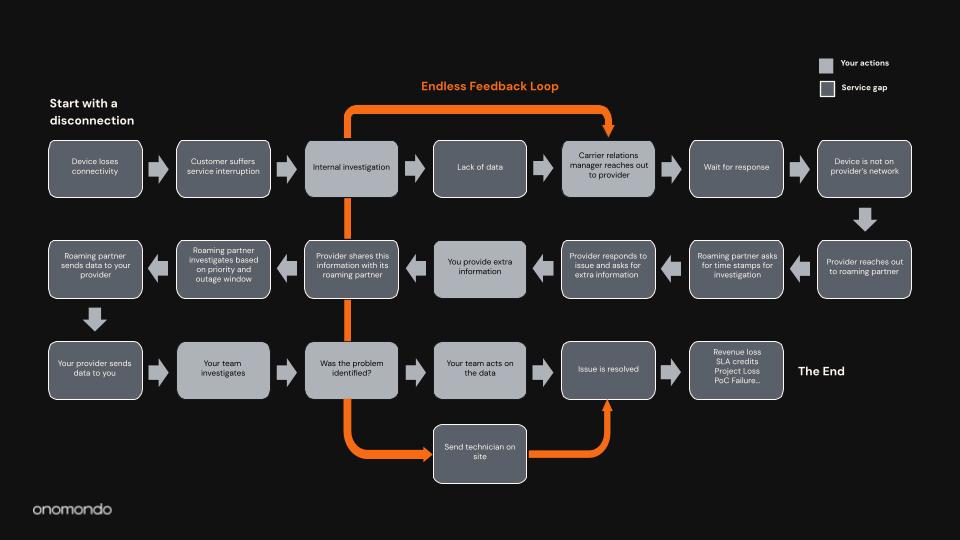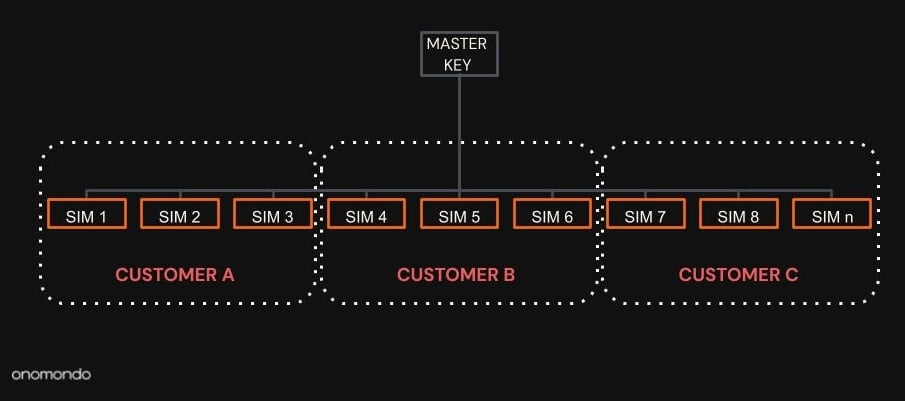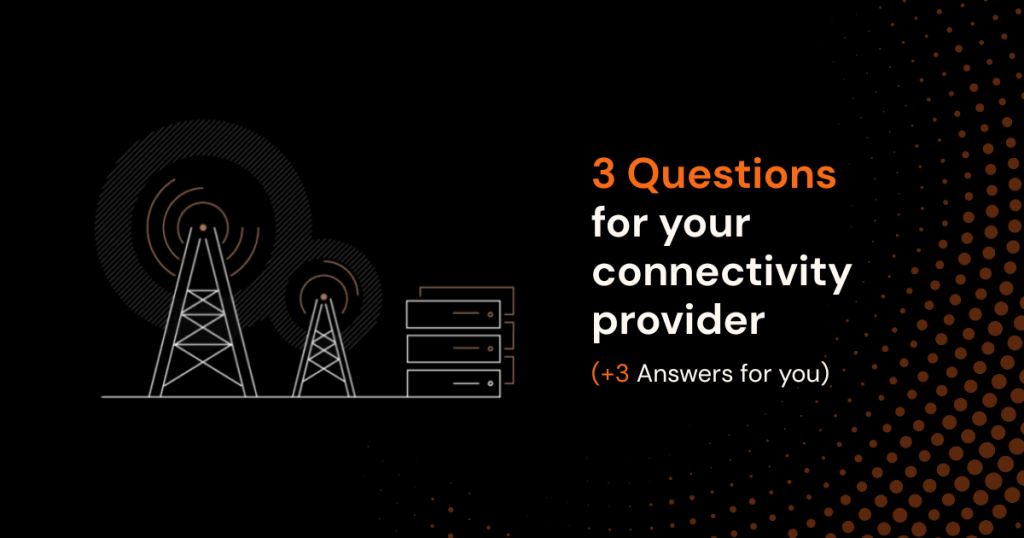The world of IoT and real-world data collection has changed, and so must the network that supports it. The demand for always-on coverage is rising fast, with global IoT connections projected to hit 30 billion by 2030. All this real-time data is feeding operational AI initiatives with massive efficiency gains.
Within this flow, expectations from employers, customers, users have shifted – we all want more with less: faster, cheaper, and safer. Hardware and software have caught up and IoT devices can do more than ever; they’re smarter, tougher, and more versatile. Even the SIM space is evolving, with long-awaited developments like eSIM IoT (.SGP.32) redefining what flexibility looks like. So far, so good – But can you wholeheartedly and confidently say that connectivity providers have evolved to respond to these changes?
That’s why we encourage you to scrutinize your prospective connectivity provider.
Because neither providers nor you can afford to treat connectivity like a commodity. You’re not buying SIM cards and data plans; you’re buying infrastructure. Your entire data strategy depends on connectivity working, and when it doesn’t, it’s binary: no connection means no data, no visibility, and a direct hit to your bottom line. IoT deployments are full of shared responsibilities, but connectivity sits at the center of them all.
So in that first 30 minutes with your prospective connectivity provider, here’s what to ask, what is an acceptable answer – and what is unacceptable.
Table of Contents
1. Am I guaranteed the best possible signal?
Before we even touch upon uptime, let’s unpack how devices connect to the network today – and how it affects both the lifetime of the device and your bottom line.
In the eyes of 3GPP, the threshold for “high quality signal” is -85 dBm. But whether your device actually connects to a network above this threshold or uses another criterion lies with your connectivity provider. Welcome to the spooky world of steering, otherwise known as the Public Land Mobile Network (PLMN) priority list.
A PLMN list, often hardcoded into the SIM, dictates the networks your device connects to – not based on signal strength, but on commercial agreements providers have with operators. In practice, this means your device may be forced to connect to a weaker signal simply because it’s higher on the PLMN list. This process, called steering, helps the connectivity provider – not you.
As a result of steering, your device can lose anywhere between 10% and 50% of its battery efficiency while struggling to maintain a weak connection enforced by the PLMN. It may also suffer dropped packets and retransmission attempts, inflating both your data bill and your frustration.
Let’s visualize it for a second. In the map below, you can see an imaginary location along with all the available radio towers.

In the annotated map below, you see a steered connection scenario:

Following the SIM’s PLMN, your device connects to ACME MNO despite several nearby towers offering stronger signals.
And here’s the alternative:

This is a non-steered map. The device automatically connects to the closest and strongest signal and tower, your coverage is better throughout and the risk of dropped packages is minimized.
Steering is, quite literally, your connectivity provider adding a rule on your device for their commercial gain. It’s the SIM overriding the logic of the radio module. Think of any instance of roaming in your private life. We have all been in a situation of roaming, where our signal is tanked and our friend’s signal is stellar, even though we are in precisely the same location. This is the result of the respective connectivity providers steering the devices in different networks because of the PLMN – not because of signal strength. We’ve come to accept it because it’s the industry norm – but that doesn’t make it acceptable.
So dare to challenge the prospective connectivity provider and ask directly: Are my SIMs steered?
And here’s how to interpret the answer. Some connectivity providers will say “no,” only to reveal later that their SIMs have dynamic or flexible priority lists. This is still steered connectivity — just with a longer leash.
The only acceptable answer is simple: No steering, no priority list. The device connects purely based on signal strength, driven by the radio module, with “good signal” defined by actual radio metrics, not commercial ones.
2. What happens when my device goes offline?
Let’s go back to the change drivers for a second: Performance demands are higher, and we expect information faster. No one wants a report of what happened yesterday – what we want is a visual of what’s happening right now. When something goes wrong, waiting to fix it is a luxury – fixing it as it occurs is the norm.
Anyone who has operated even one IoT device knows this scenario. Suddenly, there’s an unplanned loss of connectivity, a service interruption. Someone notices it – hopefully you and not your customer, though hope, as we know, is for the church – and you start investigating. But alas, you can’t have access to data you need; it’s sitting with your connectivity provider. If only the reason you deployed IoT devices in the first place was data visibility, right?
So you file a support ticket to your connectivity provider. Now if your device happens to be roaming, your connectivity provider has to reach out to their local partner to retrieve the data. You are already three touchpoints removed from the information you need. But since your device isn’t on the provider’s home network, your ticket is not prioritized.
You now depend on the provider’s provider to send data back to your provider, who will then send it to you – some days later. Only then can you begin investigating and you may or may not find the cause of the issue. And if you don’t, you start over – no 200 Monopoly dollars for you. Meanwhile, you’ve lost SLA credits, possibly revenue, and instead of collecting the proverbial 200 Monopoly dollars, you’re the one paying them, likely to send someone on-site and regain some control of the process.

This process raises the underlying question: why deploy connected devices if you have to physically interfere this much to make them work? So, what is the acceptable answer here? Certainly not the process above, not a ticketing system, nor an SLA. In fact, if you hear the words support or tickets, hang up right then and there.
The only acceptable answer is that you have direct access to connectivity data and real-time troubleshooting. Every MNO has this data, it is essential to operate their networks — but MNOs won’t share it. MVNOs, on the other hand, can’t share it, because they don’t have access to it themselves – their MNO partner does.

3. Tentative: Are you meeting the compliance requirements?
This is a trick question. The answer you’ll often get, often with far too much enthusiasm, is an alphabet soup of acronyms and a slide filled with blue certification logos. You’ve read this far so you can already sense it: that’s not the answer you’re looking for.
What you really want to know is whether your connectivity provider’s SIM security is robust enough and, more specifically, how they handle SIM keys.
Here’s the short version. Every SIM card has its own security key, which lives on the physical card. But each of those individual keys is usually generated from a single master key that belongs to the operator.
Let’s turn this around and look at what it means for you as the customer: you –and every other customer of that same connectivity provider– are dependent on the same master key to authenticate your SIM cards into the network. If one SIM is breached, the shared lineage of that key means every other SIM becomes more vulnerable.

We’ve tried to be factual and descriptive in the presentation of this process. But the truth is, this is legitimately terrifying.
The implications of a potential security breach when SIM security is managed this way are enormous. They can affect hundreds of thousands of individuals –not to mention IoT devices– and the monetary risk of a breach can easily climb into the millions of euros. And it is not just a technical risk; it’s the foundation of vendor lock-in. In addition, this vulnerability obfuscates the way forward for the arrival of eSIM IoT.
So, if your prospective connectivity provider launches into a tangent about certifications or fills the screen with blue logos, cut to the chase and ask: How do you manage your SIM keys today, and how do you transfer them? And do not accept any answer other than: a unique key for every SIM.

If you hear anything that resembles the phrase “master key”, hang up.
Why stop here? Ask more of your connectivity provider
Our relationship with data has changed.
Our expectations from technology have skyrocketed.
They have both changed our entire behaviors.
But our expectations from connectivity – the riverbed of our data – are arrested somewhere between 2004 and our personal references from our cell phone.
Connectivity can no longer be treated as a commodity, because your data isn’t a commodity. It’s the infrastructure of business decisions with real-life impact. It’s not about SIM cards or data plans anymore; it’s about whether your network can support the kind of performance, transparency, and reliability that modern systems demand.
Commercial data infrastructure depends entirely on connectivity working as infrastructure – the unseen architecture that powers uptime, data integrity, and everything your devices promise to deliver.
And while most connectivity providers still treat it like a commodity – and this is exactly the issue these 3 questions are meant to unveil – Onomondo was created because no one else was treating connectivity as infrastructure.
Onomondo’s connectivity infrastructure was built with those answers in mind from the start. A network designed so that devices always connect to the strongest possible signal. A system where data visibility is available in real time. A security-by-obscurity model where every SIM has a unique master key – not for every customer; for every SIM.
So as you step into your next IoT deployment or rethink your current one, remember: this is just the beginning of the connectivity-as-infrastructure playbook. Technology has evolved. The data has evolved. It’s time your expectations and your connectivity providers do too. Ask more; demand more from connectivity, because your bottom line depends on it.
Get in touch
Get in touch with one of our IoT experts to learn more about the Onomondo platform and connectivity solutions we provide.


